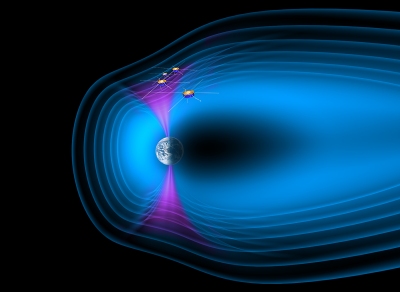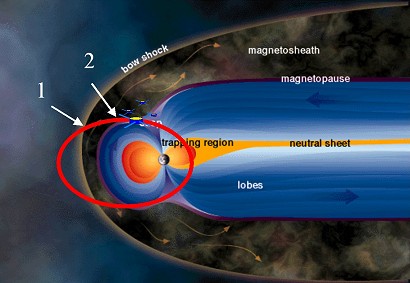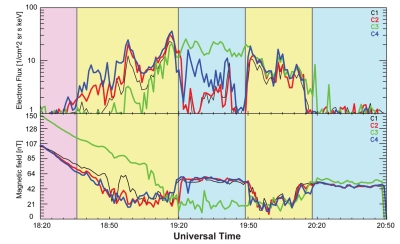Origin of particle acceleration in cusps of Earth's magnetosphere uncovered
5 June 2012
While flying through one of the cusps in Earth's magnetic field, the four spacecraft of ESA's Cluster mission have sampled the population of highly energetic particles that often fill these 'cavities'. A study of the data shows that particles are accelerated locally, within the cusps, as they cross regions characterised by different electric potential - a configuration that results from magnetic reconnection events. This is an important contribution to the long-standing debate concerning how and where these particles are accelerated.The magnetosphere of the Earth arises from the interaction between the solar wind – a stream of electrically charged particles released by the Sun – and our planet's internal magnetic field. In fact, the magnetosphere acts as a shield that prevents most of the solar wind particles from infiltrating Earth's atmosphere. The only sites where this shielding effect is not fully efficient are the polar cusps, two regions above the planet's magnetic poles where the magnetic field is extremely weak. Through the cusps, particles from the solar wind can access the upper layer of Earth's atmosphere – the ionosphere – and thus can have an impact on activities such as telecommunication networks.
 |
|
Artist's impression of the Cluster spacecraft crossing the northern cusp of Earth's magnetosphere. |
As the solar wind's direct gateway to Earth's atmosphere, the cusps are a key element in our planet's magnetic environment and have been the target of investigation for decades. In-situ measurements have shown that they are often densely populated with highly energetic particles, including electrons with energies above 40 keV and protons and oxygen ions with energies above 28 keV.
These observations have triggered an intense debate regarding the nature of such particles: exactly where and how are they being accelerated to such high energies? Several acceleration sites have been suggested in the literature: the magnetosphere, the bow shock – a standing shock wave formed in the solar wind flow as it impacts the magnetosphere – and the cusps themselves, but the issue had thus far remained open. A solid answer to these questions has now been proposed by a new study based on data from ESA's Cluster mission.
"Our analysis of the Cluster data and comparison with simulations provide the first robust evidence in favour of a local acceleration mechanism: particles are being energised within the cusps," explains Katariina Nykyri from the Embry-Riddle Aeronautical University (USA). Nykyri has led a study based on data gathered by the four Cluster spacecraft as they flew from the magnetosphere into the cusps on 14 February 2003. The results of the study are reported in a special issue of the Journal of Atmospheric and Solar-Terrestrial Physics, dedicated to studies of the cusps.
"We searched through the first five years of data in the Cluster archive, looking for an event during which the spacecraft moved from the magnetosphere into the cusps in a way that best enabled us to study how the cusp's properties vary in space and time," Nykyri explains. The event that Nykyri and her collaborators identified was particularly favourable in this context because, while the four spacecraft of the Cluster mission entered the northern cusp on 14 February 2003, their separation was very large, about 5000 km. "In the meantime, the interplanetary magnetic field changed direction from northward to southward, thus shifting the site where magnetic reconnection events occur from one side of the cusp to the opposite side," she adds.
A magnetic reconnection event is a variation in the magnetic field line configuration, which also results in the release of energy. A shift in the reconnection site changes the location, size and shape of the region of weak magnetic field in the cusp – the so-called diamagnetic cavity. As they crossed the cusp on 14 February 2003, the four Cluster spacecraft encountered a cavity whose structure was varying in space and time due to magnetic reconnection. Hence, they repeatedly entered and exited regions of weaker and stronger magnetic field; at times, three spacecraft were in the cavity and one outside of it, or vice versa.
During these crossings, the Cluster spacecraft probed the distribution of electrons, protons and oxygen ions. The data revealed that these particles have substantially higher energy within the cavity, where the magnetic field is low, whereas their energy declines farther away from it. Furthermore, the data indicated that most electrons were moving almost perpendicularly to the magnetic field's direction.
"The fact that we observe large amounts of high-energy particles in the cavity and hardly any in the magnetosheath – where the magnetic field is stronger – already suggests that the particles are being energised locally," notes Nykyry. "Nevertheless, our smoking-gun argument is the direction of motion of the electrons in the cavity," she adds. Acceleration taking place at the bow shock or in the magnetosphere would result in electrons moving mainly parallel to the magnetic field in the diamagnetic cavity. Since they appear to be moving perpendicularly to it, they must be accelerated within the cusps.
Having narrowed down the site where particles gain their energy, Nykyri and her collaborators investigated possible acceleration mechanisms. Since the data suggested that a correlation exists between changes in the cavity's structure and the occurrence of magnetic reconnection, they checked whether this mechanism could be responsible for accelerating the particles.
"We used simulations to study the dynamics of the cusp region during magnetic reconnection," explains co-author Eric Adamson from the Max-Planck-Institut für Sonnensystemforschung (Germany). "Our simulations revealed that magnetic reconnection events contribute significantly to modifying the structure of the electric potential within the cusp region," he adds. This is particularly interesting in this context since particles gain energy as they cross regions with potential differences. The simulations also showed that the cavity's geometrical configuration can efficiently trap particles for significant periods of time within the cusp.
Further simulations were run by Antonius Otto from the University of Alaska Fairbanks (USA), also a co-author of the paper, in order to investigate how much energy can be gained by particles via this mechanism. "When trapped long enough in the cavities, particles with energies of a few tens or hundreds of eV can easily be accelerated up to the observed values of 40 keV or more," explains Otto. "In particular, changes to the structure of the electric potential induced by magnetic reconnection events can boost the particles' energy gain," he adds.
This new analysis of Cluster data might not only have solved the long standing debate about the origin of high-energy particles in the cusps of Earth's magnetosphere, it also has interesting implications for other environments where magnetic reconnection takes place in a similar magnetic field line geometry. An example is the surface of the Sun, where this phenomenon is known to give rise to solar flares. "Scaling up our improved understanding of magnetic reconnection in the cusps of the Earth to the much stronger magnetic field of the Sun, we have shown that particles there can easily reach energies of the order of MeV and even GeV," notes Nykyri. This simple argument supports the hypothesis that magnetic reconnection might indeed be an important player in the heating of the Sun's corona, an issue that is still unclear in the field of solar physics.
"Understanding the physics of the cusps in Earth's magnetosphere has been one of Cluster's main science goals, and this result addresses one of the hottest topics that concerns these intriguing regions," comments Philippe Escoubet, Cluster Mission Manager at ESA. "Once more, Cluster's ability to probe Earth's magnetic field in-situ with four spacecraft has brought us a fresh view on a phenomenon, such as magnetic reconnection, that is relevant to a wide range of other physical and astrophysical environments," he concludes.
Notes for editors
The study presented here is based on data gathered by the four Cluster spacecraft on 14 February 2003 as they were moving across the northern cusp of Earth's magnetosphere. During this event, the separation between the four spacecraft was large enough (about 5000 km) that spacecraft within and outside the cusp could take simultaneous measurements. The spacecraft measured the density and energy of high-energy electrons, protons and oxygen ions, the strength of the magnetic field and the pitch angle of the particles (the inclination of the direction of motion of a particle with respect to the magnetic field).
The data collected by the four spacecraft, together with high-resolution, three-dimensional magneto-hydrodynamic simulations, suggest that the high-energy particles observed in the cusps are accelerated locally as they drift along the potential gradients created by magnetic reconnection. Not all reconnection events are able to accelerate particles up to such high energies. The particles need to remain trapped for a sufficiently long time in a region with weak magnetic field, such as the diamagnetic cavity in the cusp, in order to gain large amounts of energy.
Cluster is a constellation of four spacecraft flying in formation around Earth. It is the first space mission able to study, in three dimensions, the natural physical processes occurring within and in the near vicinity of the Earth's magnetosphere. Launched in 2000, it is composed of four identical spacecraft orbiting the Earth in a pyramidal configuration, along a nominal polar orbit of 4 × 19.6 Earth radii (1 Earth radius = 6380 km). Cluster's payload consists of state-of-the-art plasma instrumentation to measure electric and magnetic fields over a wide frequency range, and key physical parameters characterizing electrons and ions from energies of nearly 0 eV to a few MeV. The science operations are coordinated by the Joint Science Operations Centre (JSOC), at the Rutherford Appleton Laboratory, United Kingdom, and implemented by ESA's European Space Operations Centre (ESOC), in Darmstadt, Germany.
Related publications
K. Nykyri, et al., "On the origin of high-energy particles in the cusp diamagnetic cavity," 2012, Journal of Atmospheric and Solar-Terrestrial Physics, in press
K. Nykyri, et al., "Cluster observations of a cusp diamagnetic cavity: Structure, size, and dynamics," 2011, Journal of Geophysical Research, Vol. 116, A03228. DOI: 10.1029/2010JA015897
E. Adamson, et al., "3-D mesoscale MHD simulations of a cusp-like magnetic configuration: methods and first results," 2011, Annales Geophysicae, 29, 759-770. DOI: 105195/angeo-29-759-2011
Contacts
Katariina Nykyri
Embry-Riddle Aeronautical University
Daytona Beach, Florida, USA
Email: nykyrik![]() erau.edu
erau.edu
Phone: +1-386-226-6714
Eric Adamson
Max-Planck-Institut für Sonnensystemforschung
Katlenburg-Lindau, Germany
Email: adamson![]() mps.mpg.de
mps.mpg.de
Phone: +49-5556-979-468
Antonius Otto
University of Alaska Fairbanks, USA
Email: ao![]() gi.alaska.edu
gi.alaska.edu
Phone: +1-907-474-6169
C. Philippe Escoubet
Cluster Mission Manager
Research and Scientific Support Department
Directorate of Science & Robotic Exploration
ESA, The Netherlands
Email: Philippe.Escoubet![]() esa.int
esa.int
Phone: +31-71-565-3454
Matt Taylor
Cluster Project Scientist
Research and Scientific Support Department
Directorate of Science & Robotic Exploration
ESA, The Netherlands
Email: mtaylor![]() rssd.esa.int
rssd.esa.int
Phone: +31-71-565-8009




